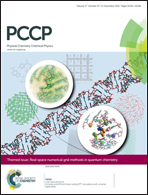Transferability of the coarse-grained potentials for trans-1,4-polybutadiene†
Abstract
In this paper, we evaluate the transferability of the coarse-grained (CG) force field (FF) of trans-1,4-polybutadiene which was built via a combined structure-based and thermodynamic quantity-based CG method at 413 K and 1 atm by systematically examining CG simulated structural and thermodynamic properties against the underlying atomistic simulation results at different temperatures. Interestingly, the derived CG force field exhibits good “state-point transferability” to some extent. For example, when applying this CG FF to the nearby state point (e.g., amorphous phase at 500 K), the resulting local conformation statistics, chain size, and local packing properties as well as density values for the CG models closely match the atomistic simulated data. When further applying this CG force field to the crystalline state at 300 K, the structural and thermodynamic properties of the crystalline phase formed for these CG and atomistic MD simulations still match within a certain level of accuracy. Furthermore, the CG torsion potential has a dual effect: for the amorphous state, the presence of an intramolecular energy barrier against rotation improves the capability of CG models to more precisely reproduce the structural properties, while in the crystalline state this CG torsion barrier suppresses the formation of the more fully stretched chain with a higher trans content. As a result, in the crystalline phase the CG model chains without torsion potentials possess a more stretched chain conformation, pack more efficiently, and have a higher crystallinity degree than its counterpart with CG torsion potentials as well as its underlying atomistic model. However, the dual effect of CG torsion potentials does not mean that we have to use different dihedral parameters to describe different state points. Both CG FFs, one with and another without torsion potentials, are able to represent the melt and the crystalline states. Overall, the phase and its structural consistency between the CG and atomistic models over other state points (e.g., crystalline phase) for which CG FFs were not explicitly parameterized very encouraging such that the combined structure-based and thermodynamic quantity-based CG method can be used to derive an optimized CG FF for multi-scale simulation of polymer systems under different thermodynamic conditions.


 Please wait while we load your content...
Please wait while we load your content...